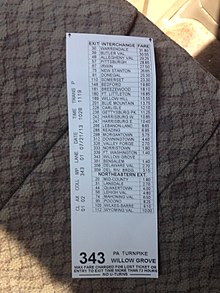
A ticket system, also known as a closed toll collection system, is a system used on some toll roads in which a user pays a toll rate based on the distance traveled from their originating entrance to their destination exit.
The correct toll is determined by requiring all users to take a ticket from a machine or from an attendant when entering the system. The ticket prominently displays the location (or exit number) from which it was issued and may contain a precomputed chart of toll rates for each exit. Upon arrival at the toll booth at the destination exit, the user presents the ticket to the toll collector, who determines the correct toll. If no ticket is presented (i.e. the ticket is lost), generally the highest possible toll is charged. For this kind of system to work, toll plazas must be built and staffed at all entrances and exits to the toll road (hence the "closed" name). Most ticket-based toll roads today use an electronic toll collection system as an alternative. In this case, sensors at both the entry and exit toll plazas read the vehicle's transponder and the correct toll is deducted from the user's account; no ticket is necessary.
First employed on the Pennsylvania Turnpike when it opened in 1940,[1] the ticket system has been utilized on lengthy toll highways in which the exits are spread out over a distance on an average of 7 to 10 miles (11 to 16 km) per exit.
- ^ Kissel, Kelly (7 October 1990). "50-Year-Old Pennsylvania Turnpike Provided Modern Road to Future : Transportation: The 160-mile route through the Appalachian Mountains was the precursor of the interstate highway system". Los Angeles Times. Retrieved February 14, 2019.
© MMXXIII Rich X Search. We shall prevail. All rights reserved. Rich X Search
